- Home
- Robert K. Massie
Nicholas and Alexandra Page 22
Nicholas and Alexandra Read online
Page 22
A revelation of Alexis’s condition would inevitably have put new pressures on the Tsar and the monarchy. But the erection of a wall of secrecy was worse. It left the family vulnerable to every vicious rumor. It undermined the nation’s respect for the Empress and, through her, for the Tsar and the throne. Because the condition of the Tsarevich was never revealed, Russians never understood the power which Rasputin held over the Empress. Nor were they able to form a true picture of Alexandra herself. Unaware of. her ordeal, they wrongly ascribed her remoteness to distaste for Russia and its people. The years of worry left a look of sadness settled permanently on her face; when she spoke to people, she often appeared preoccupied and deep in gloom. As she devoted herself to hours of prayer, the life of the court became stricter and her own public appearances were reduced. When she did emerge, she was silent, seemingly cold, haughty and indifferent. Never a popular consort, Alexandra Fedorovna became steadily less popular. During the war, with national passions aroused, all the complaints Russians had about the Empress—her German birth, her coldness, her devotion to Rasputin—blended into a single, sweeping torrent of hatred.
The fall of Imperial Russia was a titanic drama in which the individual destinies of thousands of men all played their part. Yet in making allowance for the impersonal flow of historic forces, in counting the contributions made by ministers, peasants and revolutionaries, it still remains essential to understand the character and motivation of the central figures. To the Empress Alexandra Fedorovna this understanding has never been given. From the time her son was born, the central concern of her life was her fight against hemophilia.
* At the heart of the problem of hemophilia are the genes which issue the biochemical instructions that tell the body how to grow and nourish itself. Gathered in curiously shaped agglomerations of matter called chromosomes, they are probably the most intricate bundles of information known. They determine the nature of every one of the trillions of highly specialized cells that make up a human being. Scientists know that the defective gene which causes hemophilia appears on one of the female sex chromosomes, known as X chromosomes, but they have never precisely pinpointed the location of the faulty gene or determined the nature of the flaw. Chemically, most doctors believe that hemophilia is caused by the absence of some ingredient, probably a protein factor, which causes normal blood to coagulate. But one eminent hematologist, the late Dr. Leandro Tocantins of Philadelphia, believed that hemophilia is caused by the presence of an extra ingredient, an inhibitor, which blocks the normal clotting process. Nobody really knows.
There is a remote prospect that current research into the structure of chromosomes will help hemophiliacs. If it should become possible to locate the genes responsible—and then to correct or substitute for the faulty gene—hemophilia could be cured. But medical researchers hold out little hope for the immediate future. So far, science has been unable to change genetic characteristics in any form of life except bacteria.
* Dr. Botkin kept the secret well and never discussed the illness with his own family. In 1921, his daughter Tatiana wrote a book about the Imperial family without mentioning the nature of the Tsarevich’s illness or the word “hemophilia.” This suggests either that she still did not know or that, true to her father’s code, she still felt bound by secrecy.
CHAPTER THIRTEEN
The Royal Progress
EACH year as spring crept north across Russia, the Imperial family fled the frosts and snows of Tsarskoe Selo for the flowering gardens of the Crimea. As the moment of departure approached, the Tsar’s spirits always lifted. “I am only sorry for you who have to remain in this bog,” he said cheerfully to the cluster of grand dukes and government ministers who came to see him off in March 1912.
There was a regular cyclical pattern to these annual migrations. March brought the spring exodus to the Crimea; in May, the family moved to the villa on the Baltic coast at Peterhof; in June, they cruised the Finnish fjords on the Imperial yacht; August found them at a hunting lodge deep in the Polish forest; in September, they came back to the Crimea; in November, they returned to Tsarskoe Selo for the winter.
The Imperial train which bore the Tsar and his family on these trips across Russia was a traveling miniature palace. It consisted of a string of luxurious royal-blue salon cars with the double-eagled crest emblazoned in gold on their sides, pulled by a gleaming black locomotive. The private car of Nicholas and Alexandra contained a bedroom the size of three normal compartments, a sitting room for the Empress upholstered in mauve and gray, and a private study for the Tsar furnished with a desk and green leather chairs. The white-tiled bathroom off the Imperial bedroom boasted a tub with such ingeniously designed overhangs that water could not slosh out even when the train was rounding a curve.
Elsewhere in the train, there was an entire car of rooms for the four Grand Duchesses and the Tsarevich, with all the furniture painted white. A mahogany-paneled lounge car with deep rugs and damask-covered chairs and sofas served as a gathering place for the ladies-in-waiting, aides-de-camp and other members of the Imperial suite, each of whom had a private compartment. One car was devoted entirely to dining. It included a kitchen equipped with three stoves, an icebox and a wine cabinet; a dining room with a table for twenty; and a small anteroom, where before every meal zakouski were served. Even while traveling, the Imperial suite observed the Russian custom of standing and helping themselves from a table spread with caviar, cold salmon, sardines, reindeer tongue, sausages, pickled mushrooms, radishes, smoked herring, sliced cucumber and other dishes. At dinner, Nicholas always sat at the middle of a long table with his daughters beside him, while Count Fredericks and other court functionaries sat opposite. With rare exceptions, the Empress ate alone on the train or had her meals with Alexis.
Despite the excitement of leaving St. Petersburg, a trip on the Imperial train was not an unmitigated pleasure. There was always the nagging thought that, at any moment, the train might be blown up by revolutionaries. To make this less likely, two identical Imperial trains made every trip, traveling a few miles apart; potential assassins could never know on which the Tsar and his family were riding. Worse for the travelers were the normal discomforts and boredom of long train trips. Although it could go faster, the train customarily rattled along at fifteen to twenty miles an hour. Accordingly, the trip from St. Petersburg to the Crimea meant two nights and a day of bumping and jostling across the interminable vastness of the Russian landscape. In the summer, the sun beat down on the metal roofs, turning the salon cars into carpeted ovens. It was a regular practice to halt the train for half an hour wherever a grove of trees or a river offered an opportunity for the passengers to get out, stretch their legs and cool themselves in the shade or by the water.
Once when the train was stopped in open country at the top of a high embankment, the children took large silver trays from the pantry and used them to toboggan down the sandy slope. After dinner, in the presence of the Tsar and Empress, General Strukov, an aide-de-camp, shouted to the children that he would beat them on foot to the bottom. Wearing his dinner uniform with the ribbon of Alexander Nevsky over his shoulder and his diamond-studded sword of honor in hand, the General threw himself down the bank. He slid for twenty feet, became mired up to his knees and gallantly waved as the children glided past, giggling with pleasure, on their silver saucers.
If the Imperial train was a means of travel, the Imperial yachts were a mode of relaxation. For two weeks every June, the Tsar gave himself completely to a slow, seaborne meandering along the rocky coast of Finland. By day, the yacht steamed among the islands, finding an anchorage at night in a cove deserted except for the lonely hut of an isolated fisherman. The following morning, when the passengers awoke, they found themselves surrounded by sparkling blue water, beaches of yellow sand, red granite islands and dark forests of green pines.
Nicholas’s favorite yacht was a 4,500-ton, black-hulled beauty named the Standart, especially built for him in a Danish shipyard. Moored in a B
altic cove or tied up beneath the Crimean cliffs in Yalta harbor, the Standart was a marvel of nautical elegance. As big as a small cruiser, fueled by coal and propelled by steam, the Standart nevertheless was designed with the graceful majesty of a great sailing ship. An immense bowsprit encrusted with gold leaf jutted forward from her clipper bow. Three tall varnished masts towered above her twin white funnels. The gleaming decks were covered with white canvas awnings and lined with wicker tables and chairs. Below were drawing rooms, lounges and dining rooms paneled in mahogany, with polished floors, crystal chandeliers and velvet drapes; only the private staterooms of the family were done in chintz. Along with a chapel and spacious rooms for the Imperial suite, there were quarters for the ship’s officers, engineers, stokers, deckhands, stewards, valets, maids and a whole platoon of Marine Guards. In addition, somewhere in the yacht’s lower decks, space had been found to house the members of the Standart’s brass band and balalaika orchestra.
Life aboard the Standart was easy and informal. The family mingled freely with the crew and knew many of the sailors by their first names. Often a group of ship’s officers was invited to dine at the Imperial table. During the day, the girls wandered the decks unescorted, wearing white blouses and polka-dotted skirts. Conversations and bantering shipboard flirtations sprang up between young officers and the blossoming Grand Duchesses. Even in the winter, when the yacht was laid up for refurbishing, the special bonds of shipboard life held firm. “During the performances of the opera, especially Aida,… sailors from the Imperial yacht Standart would often be called upon to play parts of warriors,” wrote the Tsar’s sister Grand Duchess Olga. “It was a riot to see those tall husky men standing awkwardly on the stage, wearing helmets and sandals and showing their bare, hairy legs. Despite the frantic signals of the producer, they would stare up at us [in the Imperial box] with broad grins.”
When the children were young, each was assigned a sailor whose duty it was to prevent his small charge from toddling overboard. As the children grew older and went ashore to swim, the sailor-nannies went along. At the end of each year’s cruise, the Tsar rewarded these husky seafaring nursemaids by giving each man a gold watch.
Even aboard the Standart, Nicholas was not free of the burdens of office. Although he barred government ministers and police security agents from the decks of the yacht, courier boats from St. Petersburg churned up daily to the foot of the Standart’s ladder, bringing reports and documents. As a further reminder of the presence of its august passenger, the yacht was never without an escort of navy torpedo boats anchored nearby or cruising slowly along the horizon.
At sea, Nicholas worked two days a week. The other five he relaxed. In the morning, he rowed ashore to take long walks through the wild Finnish forests. When the Standart moored near the country estate of a Russian or Finnish nobleman, the owner might awake to find the Tsar at his door asking politely if he might use a court for tennis. Sometimes Nicholas dismissed the gentlemen who accompanied him on these hikes and walked alone with his children, searching the woods for mushrooms or wandering down a beach looking for bright-colored rocks.
Because her sciatica made it difficult for her to move, Alexandra rarely left the yacht. She spent the days peacefully sitting on deck, knitting, doing needlework, writing letters, watching the gulls and the sea. Alone in the lounge, she played Bach, Beethoven and Tchaikovsky at the piano. As they grew older, the girls took turns staying aboard the ship, keeping their mother company. In 1907, when Anna Vyrubova began making these cruises, the two women spent their days sitting in the sun, knitting and talking.
At teatime, the Tsar and the children returned with stories, wildflowers, mosses, cups of berries and pieces of quartz. Tea was served on deck while the ship’s band thumped out marches or the balalaika orchestra strummed Russian folk melodies. Occasionally, the girls acted out skits. Anna Vyrubova recalled the day that the older Imperial yacht, Polar Star, carrying the Dowager Empress, anchored nearby and the girls’ grandmother came on board the Standart for tea and a play. Afterward, Vyrubova saw Marie “sitting on Alexis’s bed talking to him gaily and helping him peel an apple just like any other grandmother.”
The part of the day Alexandra liked best was sunset. As the last slanting rays touched trees, rocks, water and boats with golden light, she sat on deck watching the lowering of the flag and listening to the deep, echoing male voices of the crew singing the Orthodox service of Evening Prayer. Later in the evening, while Nicholas played billiards and smoked with his staff, the Empress read and sewed by lamplight. Everyone went to bed early. By eleven p.m. the waves had rocked them to sleep, and stewards bringing evening tea into the drawing room invariably found the place deserted.
In 1907, the cruise on the Standart ended in near-calamity. The yacht was moving out to sea through a narrow channel while, on deck, the passengers were having afternoon tea. Suddenly, with a shuddering crash, the ship hit a rock. Teacups flew, chairs overturned, the band went sprawling. As water poured into the hull, the ship listed and began to settle. Sirens wailed and lifeboats were lowered. For a moment, the three-year-old Tsarevich was missing, and both parents were distraught until he was located. Then Alexandra herded her children and maids into boats and, with Anna Vyrubova, bustled back to her own stateroom. Stripping sheets from the bed, she tossed jewels, icons and mementoes into a bundle. When she left the yacht, the last woman to depart, she carried this priceless bundle securely in her lap.
Nicholas, meanwhile, stood at the rail supervising the lowering and casting off of the lifeboats. As he did so, he bent over the side every few seconds and looked at the waterline, then consulted a pocket watch he held in his hand. The Tsar explained that he intended to stay aboard to the last, and that he was calculating how many inches a minute the boat was sinking; he estimated that twenty minutes remained. Nevertheless, due to its watertight compartments, the Standart did not sink, and it was later pulled off the rock and repaired. That night the family slept in crowded quarters aboard the navy cruiser Asia. “The Emperor, rather disheveled, brought basins of water to the Empress and me to wash our faces and hands,” said Anna. “The next morning, the Polar Star appeared and we transferred to its more spacious quarters.”
In August 1909, the Standart steamed slowly past the Isle of Wight, carrying the Russian Imperial family on its last visit to England. The Tsar arrived just before Regatta Week, and before the races began, King Edward VII honored Nicholas with a formal review of the Royal Navy. In three lines, the world’s mightiest armada of battleships and dreadnoughts lay at anchor. As the British royal yacht, Victoria and Albert, steamed slowly under the rail of each of these mountains of gray steel, pennants dipped, saluting cannon boomed, bands played “God Save the Tsar” and “God Save the King,” and hundreds of British seamen burst into rippling cheers. On the deck of the yacht, the portly King and his Russian guest, wearing the white uniform of a British admiral, stood at salute.
After the naval review, the sailing races which climaxed the summer social season began. A great fleet of hundreds of yachts lay in the roadstead, their varnished masts gleaming in the sunlight like a forest of golden spars. “Ashore and afloat,” wrote a British observer, “there were dinner parties and balls. Steam launches, with gleaming brass funnels, and slender cutters and gigs, pulled by their crews at the long white oars, plied between the yachts and the Squadron steps. By day, the sails of the racing yachts spread across the blue waters of the Solent like the wings of giant butterflies, by night the riding lights and lanterns gleamed and shone like glow-worms against the onyx water and fireworks burst and spent themselves in the night sky.”
This visit was the only time that Prince Edward, the present Duke of Windsor, met his Russian cousins. Prince Edward, then fifteen, and his younger brother Prince Albert, who became King George VI, were cadets at the Naval College of Osborne, near Cowes on the Isle of Wight. Both British Princes were scheduled to show the Russian party through their school, but, at the last minute, Albert develop
ed a cold which rapidly worsened into whooping cough. Dr. Botkin feared that if Albert passed the disease along to Alexis, the fits of coughing might trigger bleeding. Accordingly, Albert was quarantined.
“[This] was the one and only time I ever saw Tsar Nicholas,” wrote the Duke of Windsor, looking back on the event. “Because of assassination plots … the Imperial government would not risk their Little Father’s life in a great metropolis. Therefore the meeting was set for Cowes on the Isle of Wight, which could be sealed off almost completely. Uncle Nicky came for the regatta with his Empress and their numerous children aboard the Standart. I do remember being astonished at the elaborate police guard thrown around his every movement when I showed him through Osborne College.”
The Empress Alexandra was overjoyed to be back in the land where she had spent the happiest days of her childhood. Pleased with the warm hospitality offered by King Edward, she wrote that “dear Uncle” has “been most kind and attentive.” Less than a year later, “dear Uncle” was dead. His son, King George V, was on the throne and the young Prince Edward became the Prince of Wales.
Every emperor, king and president in Europe trod at one time or another upon the polished decks of the Standart. The Kaiser, whose own 4,000-ton white-and-gold Hohenzollern was slightly smaller than the Standart, openly proclaimed his envy of the Russian yacht. “He said he would have been happy to get it as a present,” Nicholas wrote to Marie after William had come aboard for the first time. In reply, Marie sputtered indignantly, “His joke … was in very doubtful taste. I hope he will not have the cheek to order himself a similar one here [in Denmark]. This really would be the limit, though just like him, with the tact that distinguishes him.”

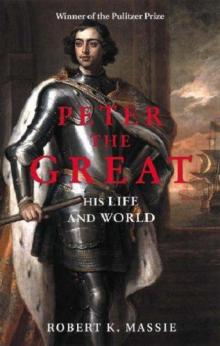 Peter the Great
Peter the Great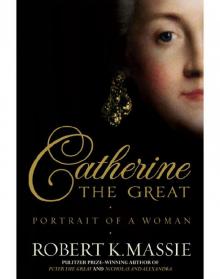 Catherine the Great
Catherine the Great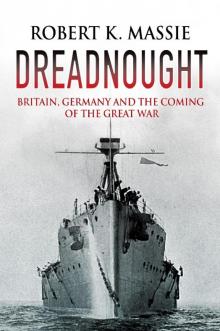 Dreadnought
Dreadnought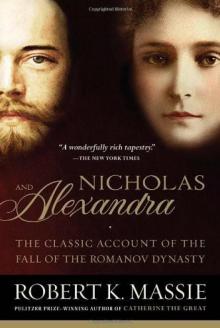 Nicholas and Alexandra: The Classic Account of the Fall of the Romanov Dynasty
Nicholas and Alexandra: The Classic Account of the Fall of the Romanov Dynasty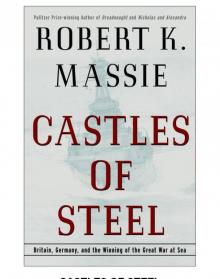 Castles of Steel
Castles of Steel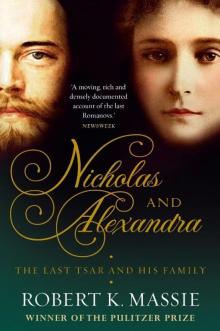 Nicholas and Alexandra: The Tragic, Compelling Story of the Last Tsar and his Family
Nicholas and Alexandra: The Tragic, Compelling Story of the Last Tsar and his Family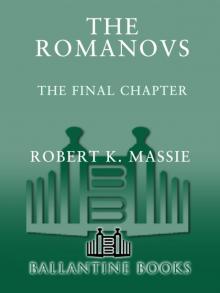 The Romanovs
The Romanovs Dreadnought, Britain, Germany and the Coming of the Great War
Dreadnought, Britain, Germany and the Coming of the Great War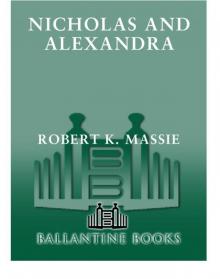 Nicholas and Alexandra
Nicholas and Alexandra